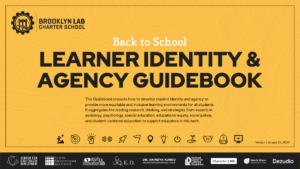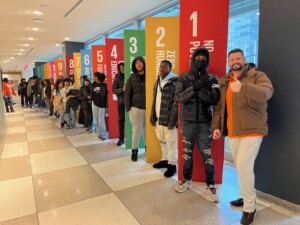Students and Equity at the Heart of School Redesign

Schools and districts are often in the business of designing. Whether it be curriculum, learning experiences, schedules — much of the world of education stems from arranging ideas into patterns and pathways. This year, schools and districts were asked to design like never before and, to do this, they benefited from a set of supports and tried and true design processes that were human-centered and equity-focused in nature.
During this tumultuous time, seven districts were supported by the Strategy Lab, an initiative from The Learning Accelerator. This group aimed to utilize design thinking through the Real-Time Redesign process to assist in capacity building with school leaders.
This design was often “real-time” due to urgency and regularly hinged upon bringing together teams with diverse experiences and ways of thinking. Their goal was to “dream big but start small” to ensure actionable steps towards change and transformation. In fact, the three steps of this process are:
- Come Together: Assemble an inclusive design team while also unearthing challenges your schools are facing, and explore innovative practices around the country.
- Dream Big: Clarify the targeted improvement you seek and identify potential solutions.
- Start Small: Build a prototype of a solution and then pilot it on a small scale.
We spoke with leaders from several participating districts who walked us through what this design cycle was like.
Indianapolis Public Schools
Problem of Practice: Literacy Rates
After the pandemic disrupted the 2020 school year the Indianapolis Public School District (IPS) team conducted a Dynamic Indicators of Basic Early Literacy Skills (DIBLES) assessment and found that 64% of their K-3 students were below reading level. Chief Academic Officer Dr. Warren Morgan determined that literacy would need to be the top priority of the academic team, and decided to focus their work in the Strategy Lab on piloting solutions to the problem. Kassi Hall, Multi-tiered Systems of Support Coordinator, and Amanda Koth, the Director of Instructional Design and Support, set off to understand the challenges more deeply and start to identify solutions through their work in the Strategy Lab.
Transformation is often a difficult process. That’s why the Strategy Lab commitments, pace and process were so helpful to IPS. “It helped us to know that we’re trying to change a behavior — it doesn’t have to be a huge outcome,” said Hall, “Lets see how we can enhance this one grade level and then see what we can replicate.”
To begin, IPS held empathy interviews with teachers and coaches. The findings were that the curriculum was at a much higher difficulty than the students were ready for. They also found that educators rarely went back to teach a skill after teaching it, assuming mastery without the necessary proof of knowledge. The question became: “how do we take time at tier-one [instruction] to let the students learn skills but at their own reading level?” It involved going back to module levels that they hadn’t yet mastered. Reteaching became relearning.
Working to Truly Know the Students
Of course, the students were scattered across all skills and levels, and it was challenging to navigate and streamline these skills. To better address this challenge, Kassi put herself in the students’ shoes asking of herself, “what skills am I being introduced to in a day and a week?” She began connecting the dots between all curriculum resources and the skills that were necessary. The results was a flexible model that enabled teachers to go back and teach a module over again based on professional judgment or to try and apply the lessons learned to what they are currently teaching.
During this process, she observed one of their teachers conducting an interview with a student in their native language of Spanish. This moment of true connection and intentionality around better knowing one of the learners was indicative of the greater shift that had occurred within the scope of the design cycle, an renewed commitment to keeping students, and their context, at the center.
To continue this work, the district is currently working on creating a multifaceted year of professional learning to support teachers’ foundational skills and the learning science for cultivating literacy in young students, while continuing to conduct empathy interviews within their community and honing their approach to their problem of practice.
Takeaways
- There is a great benefit to learning from process and iteration. Not all plans need to point towards an official solution.
- When redesigning teaching and learning, focus on defining the problem and identifying behavior changes that work to combat it.
Monterey Peninsula Unified School District
Problem of Practice: Belonging and Connection
The Monterey Peninsula Unified School District (MPUSD) noticed soon after the pandemic hit that something was off, and it wasn’t easy to put their finger on. In order to identify the problem of practice, the district leaders ran a rapid-cycle design session with a cohort of teachers and high school students.
Over the past few years, MPUSD has taken steps to build capacity among their faculty through elevating student voice in student panels and empathy interviews. They have also been conducting numerous trainings on understanding bias for their teacher teams and Independent Learning Teams (ILT). The rapid-cycle design work was a natural fit into this district-wide mindset work.
Through the design process, leadership discovered that feelings of belonging and connectedness, as indicated by YouthTruth student survey data, were at an all-time low throughout the district. Cresta McIntosh, Associate Superintendent for Educational Services at MPUSD was determined to ask the right questions early in the process: “How do we best involve stakeholders?”
This commitment to involving community members and students allowed for these stakeholders to design for their peers, in turn, designing for themselves. This process included teachers as co-designers, allowing students to take the lead and design outstanding solutions collaboratively.
Driven By Student-Led Design
Throughout the process, the district emphasized many of the key components of equitable design: designing to the margins, addressing inherent and problematic power structures, and truly helping learners lead the design process. They placed nine students into three groups of three and had them co-design with the principal and teachers to answer the question of: “How do we support belonging and connectedness?”
The three groups came up with prototypes that they will test in their communities in the coming months. They will then execute more empathy interviews to solicit feedback and get a better understanding of impact.
McIntosh said that the district is now asking: “How do you take this and expand and extrapolate the idea even bigger. This isn’t just because of COVID.” The solution is only just beginning and they are now able to better address the challenge due to the Real-Time Redesign process.
Takeaways:
- Students should be at the center of design. It is rewarding, builds capacity and changes the mental models around power.
- Start small and let those learnings inform scaling efforts towards larger transformation.
Austin Independent School District
Problem of Practice: Standards-Based Instruction
Austin Independent School District (AISD) had put a lot of work into culture building for standards-based practices. This momentum had largely taken hold in secondary. Then, on July 1st, Suzanne Newell, Director of Academics, joined the team. Alongside colleagues Erin Bown-Anderson, Assistant Superintendent for Academics; David Reinhart, Director of Professional Learning; and Ty Davidson, Executive Director of High Schools, Suzanne set to work on exploring innovations surfaced in the pandemic – in particular, standards-based learning – through the Strategy Lab. As a team, they rallied around the questions of, “How do we not waste a good crisis? How do we use this to accelerate good practice?”
“How do we meet the new needs that teachers have but also advance some of the practices that we knew need to be advanced and would be harder to do in the former [pre-COVID] culture?” Newell asked.
How Do We Know What We Know?
Through the Real-Time Redesign process, AISD was able to pinpoint the problem they were really trying to solve. They had noticed a dip in middle school performance data and after conducting empathy interviews and surveys with teachers, students and leaders, they learned that one of the key missing pieces was clarity around standards.
Through a careful vetting process, the district identified a middle school that was uniquely primed for standards-based practices, found four teachers and an instructional coach who would be willing to, as Newell put it, “play in the sandbox” and started reading Catlin Tucker’s Balance with Blended Learning, an inspiring book that was deeply rooted in mastery and standards-based learning.
“There is no better gasoline in the tank than bringing the students into the process, it’s hard for an educator not to listen,” said Suzanne Newell.
AISD is currently in the process of launching their updated approach focused on student grade interviews, after getting set back from the winter storms that ravaged Texas in February 2021. Through carefully constructed pre-/post-surveys, they will be measuring the impact of the pilot on students’ agency and their understanding of the standards.
Takeaways:
- Students need to understand how to prove their knowledge and what is expected of them. Transparency of learning goals is essential to student thriving.
- Bringing students into the process of designing is a great way to get educators more engaged and rejuvenated.
Learners & Equity
One of the key threads through each district’s experience was the exponential rate of change through equitable frameworks and keeping the learners at the center of design. By using these two mindsets, the design teams were better able to keep the problem of practice in focus and design for those who truly need it rather than making assumptions.
The process ensured that the design teams executed the following practices :
- Identify concrete problems of equity and resiliency.
- Make targeted improvement towards bigger change.
- Engage authentically and inclusively with those most affected.
Now more than ever is the time to be intentional, strategic and equitable in school redesign work. The new Real-Time Redesign Toolkit from The Learning Accelerator, derived from experiences in the Strategy Lab, can help educators develop the capacity for asking the right questions and can help make targeted, meaningful improvement towards more equitable and resilient teaching and learning.
What’s your problem of practice?
For more, see:
- Building the Car While We’re Driving It
- TLA’s Real Time Redesign Toolkit Helps Schools Make Positive Change
Stay in-the-know with innovations in learning by signing up for the weekly Smart Update. This post includes mentions of a Getting Smart partner. For a full list of partners, affiliate organizations and all other disclosures, please see our Partner page.






0 Comments
Leave a Comment
Your email address will not be published. All fields are required.